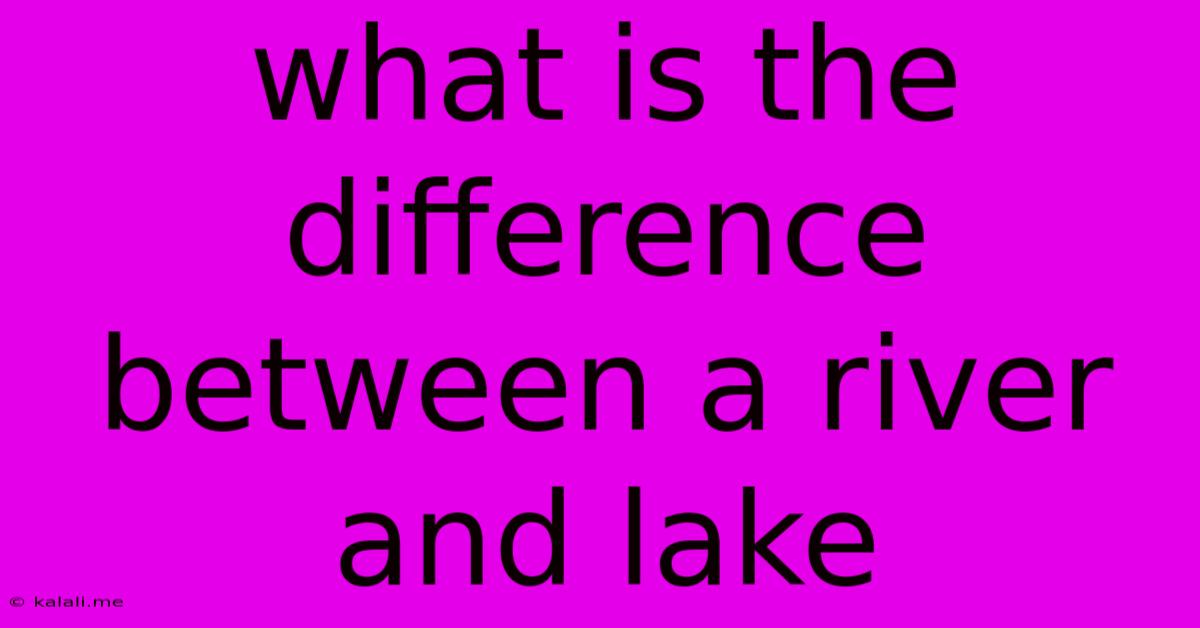What Is The Difference Between A River And Lake
Kalali
Jun 13, 2025 · 3 min read

Table of Contents
What's the Difference Between a River and a Lake? A Deep Dive into Aquatic Ecosystems
While both rivers and lakes are bodies of freshwater (though some lakes are saltwater), they differ significantly in their characteristics, formation, and ecological roles. Understanding these differences is key to appreciating the unique biodiversity and environmental importance of each. This article will explore the key distinctions between rivers and lakes, helping you understand these vital aquatic ecosystems.
Rivers are flowing bodies of water that continuously move in one direction, typically towards the ocean, a sea, or another river. Lakes, on the other hand, are relatively still bodies of water with little or no current. This fundamental difference in water movement dictates many other key characteristics.
Flow and Current: The Defining Difference
The most obvious difference lies in the water's movement. Rivers possess a consistent, unidirectional flow, driven by gravity and influenced by factors like rainfall, snowmelt, and the slope of the land. This constant flow shapes the river's features, carving channels, transporting sediment, and influencing the types of organisms that can thrive within it. Lakes, in contrast, exhibit minimal to no current, apart from localized wind-driven currents or density-driven stratification. Their water largely remains stagnant, leading to different ecological processes.
Shape and Size: A Visual Comparison
Rivers are typically long and narrow, following a defined channel or course. Their shape is largely determined by the topography of the land and the erosional forces of the flowing water. Lakes, conversely, can vary significantly in size and shape. Some are small, shallow ponds, while others are vast, deep expanses of water. Their shape is often determined by geological factors like glacial activity, tectonic movement, or volcanic activity. Consider the difference between the mighty Amazon River and the serene, expansive Lake Baikal – a stark illustration of this point.
Water Depth and Light Penetration: Ecological Implications
Water depth plays a crucial role in the ecosystems of both rivers and lakes. Rivers generally have a relatively shallow depth, allowing sunlight to penetrate to the bottom, fostering photosynthesis and supporting diverse plant life. Lakes, however, can range from shallow to extremely deep. Deeper lakes often exhibit stratification, with distinct layers of water differing in temperature and oxygen levels, impacting the distribution of organisms. Light penetration is also affected by depth and water clarity; deeper sections of lakes may experience limited sunlight, resulting in unique adaptations in the aquatic life found there.
Biodiversity and Ecosystem Dynamics: A World Apart
The differences in flow, depth, and nutrient levels contribute to vastly different ecosystems. Rivers support a variety of organisms adapted to flowing water, including fish capable of strong swimming, invertebrates that cling to rocks, and riparian vegetation along the banks. Lakes support a more diverse array of organisms, depending on their size and depth. They can host a variety of fish species, diverse plankton communities, and submerged and emergent aquatic plants. The relatively still nature of lakes can lead to different nutrient cycling processes compared to the more dynamic river systems.
Formation and Origins: A Geological Perspective
The formation processes also differ significantly. Rivers are primarily formed by the continuous flow of water eroding the land over time. Lakes, on the other hand, can be formed through a multitude of processes, including glacial activity (forming glacial lakes), tectonic activity (forming tectonic lakes), volcanic activity (forming crater lakes), and even human activity (forming reservoir lakes).
In conclusion, while both rivers and lakes are essential components of the global water cycle and vital habitats for diverse life, their fundamental differences in water flow, shape, depth, and ecological dynamics make them unique and fascinating aquatic ecosystems. Understanding these differences is crucial for effective conservation and management efforts.
Latest Posts
Latest Posts
-
Which Of The Following Is True About The Gdp Deflator
Jun 14, 2025
-
Who Is Considered The Father Of The Computer
Jun 14, 2025
-
Newtons Second Law Questions And Answers Pdf
Jun 14, 2025
-
At What Temperature Does Water Freeze In Fahrenheit
Jun 14, 2025
-
The Art Of Effective Or Persuasive Speaking Or Writing
Jun 14, 2025
Related Post
Thank you for visiting our website which covers about What Is The Difference Between A River And Lake . We hope the information provided has been useful to you. Feel free to contact us if you have any questions or need further assistance. See you next time and don't miss to bookmark.